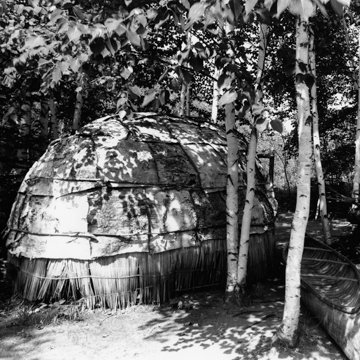Waswagoning offers visitors a re-created Ojibwe village on the shore of Moving Cloud Lake on the Lac du Flambeau Reservation. This exhibit by Nick Hokking and members of the Lac du Flambeau band depicts Ojibwe wigwams, utensils, and material goods. Wigwams were the major house type used by local native people in the wooded headwaters of the Mississippi River tributaries. Women could quickly erect these simple structures from materials growing wherever the band moved the camp. Women gathered flexible saplings, removed the bark, sharpened one end (though, more commonly, poles were reused from the previous camp), and inserted the poles into the ground in a circle or oval outline. They then bent the poles over to meet a sapling from the opposite side and lashed them together with cordage made from the inner bark of a tree or with leather thongs. Smaller saplings linked the vertical poles. The result was a domed framework, on which birch bark or woven cattail mats were hung and tied in place. A hole in the center of the roof allowed the smoke from the campfire to escape, and an eastward-facing doorway provided access. A hide or blanket served as a door.
You are here
Waswagoning
If SAH Archipedia has been useful to you, please consider supporting it.
SAH Archipedia tells the story of the United States through its buildings, landscapes, and cities. This freely available resource empowers the public with authoritative knowledge that deepens their understanding and appreciation of the built environment. But the Society of Architectural Historians, which created SAH Archipedia with University of Virginia Press, needs your support to maintain the high-caliber research, writing, photography, cartography, editing, design, and programming that make SAH Archipedia a trusted online resource available to all who value the history of place, heritage tourism, and learning.


